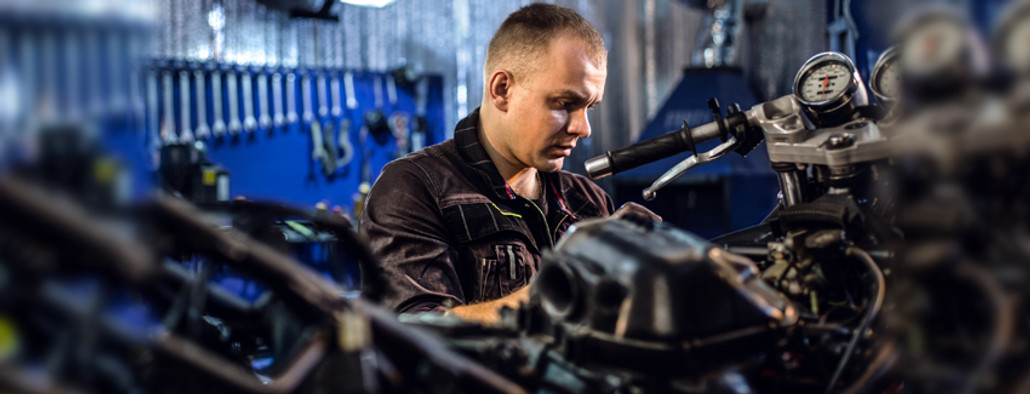Changing your own oil
Posted by Team Motorcycle on Jul 8th 2016
| Working on your own motorcycle can seem like a daunting task, but breaking into the hobby may not be as difficult as you think. Instead of looking at all the complexities of the components of your motorcycle and feeling overwhelmed, start small and simple. A good place to break into the hobby is with the most essential maintenance required to keep your engine running; the oil change. Keeping the oil in your motorcycle fresh and clean is the most fundamental factor in ensuring that your bike's powerplant is able to do its job correctly and efficiently. As complex as |
|
|
| an engine itself is, you can take comfort in the fact that changing its oil is really quite simple. Learning to do the job correctly will not only save you money, but also help to familiarize you with your machine and give you a better understanding of how it operates. | ||
| Before you roll up your sleeves and get started it's crucial that you make sure you have the correct tools. You'll need sockets or wrenches for removing the necessary bolts, a catch pan for collecting the old oil that drains out of the engine, and of course some fresh oil. A strap wrench for external oil filters and nitrile or latex gloves are optional but may not be needed. Refer to your motorcycle owner's manual for a listing of the specific type of oil that is required as this varies from model to model. Also please be sure to get rid of your spent motor oil properly by taking it to a recycling or safe disposal center. | ||
|
Despite the minor differences in bolt sizes and oil weights from bike to bike, the oil change procedure is essentially identical in concept across them all. Let's begin at the oil's entry point into the engnie. There is a fill cap located just above the crankcase on the side of nearly all motorcycle engines. Typically it doesn't require any tools to remove and can simply be loosened with your hand. If you look closely at the engine case near the cap you should find a stamped mark that tells you exactly how much oil your particular engine will hold when full. Never exceed the amount listed as excessive oil levels can cause permanent damage! | |
| Most motorcycles also have something called a "sight glass" which is located lower down on the side of the engine. As its name implies, you can look through this window and visually check the oil level in your engine at a glance, no dipstick required! Working down further, we find at the bottom of the engine on its lowest point, the drain plug bolt. There may be other bolts in the area so again consult your manual to make sure you've got the right one before you drain anything. | ||
| Now that you know what you're looking at and you have everything you need to do the job you should warm up the engine. This can be done by letting the bike idle a while or by taking it for a short ride down the road. The warmer the oil is the more freely it will flow, meaning less time waiting for it to drain. Park the bike so that it is stable and level. With the oil catch container in place, carefully loosen the oil drain bolt. Try not to drop it in the hot oil! Did you know that oil drain bolts are usually magnetic? Check the bolt's tip; if you see a lot of metal shavings, it could be an indication of excessive engine wear. Wait five to ten minutes for all of the oil to |
|
|
| drain, then reinstall the plug. This is probably a good time to talk about oil filters. Your motorcycle has an oil filter installed either internally or externally. Internal filters are usually bolted to the oil pan, while external filters simply screw onto the front or side of the engine by hand. They do not need to be replaced every oil change. Many people go by a rule of switching the filter out for a fresh one every third oil change, though some choose to do so more frequently. They are usually fairly inexpensive and can be purchased at most any auto parts store, just make sure you have the correct part number if you replace it. External filters should only be hand-tight, and all filters should have their rubber seals greased with motor oil prior to installation to prevent tears or distortion of the surface. Remember: Oil filters hold some volume of oil, so the amount of oil you put into your bike will be different with and without a filter change. | ||
| Now that your engine is empty of all that dark, worn-out oil, it's time to replace it with the beautiful honey-colored lifeblood that you purchased earlier. Unscrew the oil fill-cap and carefully pour in the pre-measured amount necessary for your engine. Once you've got the proper volume added you can replace the cap, put away all your tools, and take a test drive! I personally always recommend warming the bike up again by riding or letting it idle after an oil change so get everything circulating. I then turn the engine off, let the oil drain down into the oil pan for a minute or two, and use the sight glass to check the oil level one more time. Double-checking your work can save you big headaches in the future and is an excellent habit to get into. You can now ride with the confidence that seeing through a job done right instills! | ||




